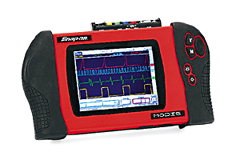
-
3059 Durand Ave. Racine, WI 53403
- 262-554-1170

- 3059 Durand Ave. Racine, WI 53403
- 262-554-1170


History of Computer Controlled Engine Management
Before the advent of computer controlled engine management systems, the source of many auto malfunctions was something you could see. Pop off the distributor cap and you could see burned or closed points, carbon tracks that would cause a misfire or a cracked cap or cracked rotor. You could look down the throat of the carburetor and observe the fuel flow and atomization. A simple compression test revealed a lot of information about the mechanical condition of the motor. Altogether there were not many parts involved in the operating system of the engine; just a distributor, spark plugs, ignition cables and a carburetor.

Beginning in the late 1970s in order to meet federal emission and fuel economy standards manufacturers began to add electronic controls and sensors to the fuel and ignition systems. In 30 years electronic controls have evolved and expanded exponentially. Now electronic management is thoroughly integrated into most systems. Engine controls, transmission controls, antilock brakes, traction control, air bags, automatic climate control and collision avoidance systems are present in today’s vehicles and the number of sensors and operating devices number in the hundreds.
Diagnostic Procedures
When there is a malfunction in any of these systems, a warning light will illuminate. The computer that regulates the system can narrow down the source of the malfunction by setting a code which identifies the area or circuit the problem exists in, but rarely does it identify the exact cause. We often have vehicle owners come in who have gone to a parts store for a free diagnosis, bought and installed a certain part and still have the same malfunction. Retrieving the code from the computer is only the beginning of the process. The next steps are to test the appropriate output signals from sensors, test the incoming signals to the operating devices and test to see if the operating devices are performing the correct function when activated. This thorough type of diagnostic procedure is what results in repairing the problem right the first time.
Know What Your warning Lights Mean!
Check Engine Light or Engine Symbol: A malfunction in the engine management system, usually emissions related. If the light flashes the car should not be driven because damage could result.
ABS or Antilock: Usually means there is a problem in the antilock portion of the braking system. The brakes should continue to work but the skid-preventing function may not operate.
SRS, Airbag or Airbag Symbol: The airbags may not deploy in an accident. In rare instances it could indicate a short that could cause an airbag to deploy without warning. This condition should always be investigated by a repair facility.



Copyright © 2025 - All Rights Reserved - pinkallaautosolutions.com
Template by OS Templates